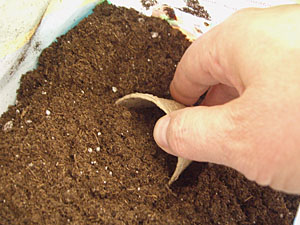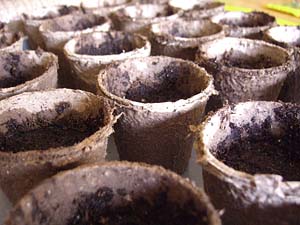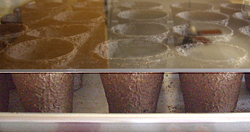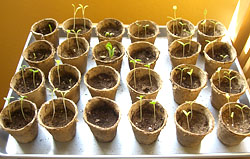Survival Garden Seed Germination
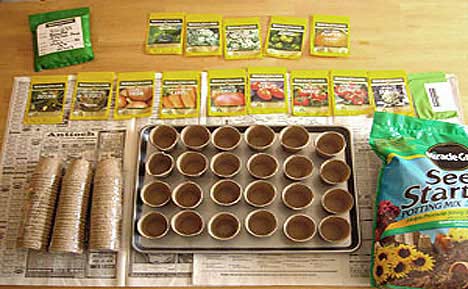
Growing your own Survival Garden, similar to the World War II era ‘Victory Garden’, is not only a rewarding experience that builds a key survival skill, but it enables you to be less dependent upon today’s modern food systems, is healthier, and will save you money.
The first step beyond the planning stage and procurement of seeds (use Heirloom varities) is seed germination. Germinating your own seeds will save even more money from otherwise having to purchase your own young plants. Get the most from your survival garden this year and sow your seeds on time. Start your seeds indoors, early enough to move seedlings outside as soon as the weather permits in your local area…
Discover your zone and last frost date (US growing zone finder), and then work backwards to figure out when you should start your indoor seeds. For example, if you are in Zone 8, the last frost date is early April, say, April 7. If your tomato seed packet instructions say to sow indoors 5 – 7 weeks before last frost date, then you could start the seeds indoors as early as the end of February. The more accurate you are to start them on time, the better opportunity you will have to a longer growing season and bigger harvest.
Soil for Seed Germination
The best and simplest choice of soil to use for seed germination is to use ready-made ‘starter’ soil specifically designed for germination. Using generic ‘real’ soil will risk having contaminants or disease spores which could harm young seedlings.
Seed-starting soil is hardly soil at all… for example, the Miracle-Gro Seed Starting potting mix that I’ve used includes a mixture of 90% phagnum peat moss, and 10% perlite.
Regarding potting soil in general, rather than purchasing premixed potting soil, there are lots of recipes out there how to make your own. The ideal mix should be able to hold some moisture but drain well, and supply nutrients.
Typical ingredients for generic all-purpose potting soil include varying portions of sphagnum peat moss, perlite, vermiculite, sharp sand (builders sand), compost, and soil. Check online for potting mix recipes and ideas, which vary depending on your plants and needs.
Note that Seed Starting Mix typically does not include soil because its main purpose is to simply hold moisture with a consistency that does not compact easily and has good drainage. Peat moss mostly serves this purpose.
‘Sphagnum’ peat moss refers to the moss that grows on the top of peat bogs.
‘Sharp sand’ has angular edges and differing granule sizes which allows for better drainage.
Here are a few generic potting mix recipes. There really are lots of recipes out there, but most include a common set of ingredients including Sphagnum Peat Moss, Vermiculite (or Perlite), Compost, and Builders Sand (Sharp sand).
Recipe for seed starting potting mix
- 2 part sphagnum peat moss
- 1 part perlite
- 1 part vermicultie
Recipe for potting mix
- 1 part Sphagnum Peat Moss
- 1 part Vermiculate
- 1 part Compost
- 1 part Coarse or Sharp Sand (Builders Sand)
Containers for Seed Germination
The seed germination containers should be a few inches deep and must be able to drain excess moisture (holes in the bottom). You could fabricate your own or buy your own seed trays. There are some nice seed tray kits available online. Just be sure they drain, and ideally have a see-through cover which helps to keep the moisture inside while providing light to the seedlings after they sprout.
Peat pots make for an easy transplant to outdoors since the roots will grow right through the pots (or simply peel away the material itself) and therefore don’t cause any root damage compared to having to remove the young plant from a solid container (if handled with care, this shouldn’t be a problem).
How to Germinate Seeds
The process begins with the right potting mix, seed starting trays or pots, and of course the seeds.
Fill the pots and moisten the mix, or moisten the mix and fill the pots. The mix should be quite saturated to the point where the excess is just draining out.
You can use the eraser side of a pencil to press into the mix to the recommended depth, which is typically one eighth to one quarter inch for many common vegetable seeds. The rule of thumb is twice the depth of the seed dimension. Don’t forget to sketch out a map which shows what seed varieties are in each location in your tray – unless of course they are all the same.
The key factors for successful germination are moisture and temperature. You could actually germinate seeds in a folded paper towel so long as it is kept moist and between 70 and 80 degrees Fahrenheit. Of course once it sprouts you will soon have to move it directly to a potting mixture for additional nutrients.
After dropping the seed into the soil, cover it with soil and press lightly. After the process is completed, it is beneficial to cover the tray or pots to help keep the soil moist. It is critical to keep the seeds moist. If they dry out, the seeds will die. Most of the seed starter tray kits will come with a snap-on clear plastic cover.
The temperature needs to be warm, 70 – 75 degrees for most seeds to germinate. Keep your seed trays in a location where they will stay warm, but not in direct sunlight where it might heat up too much, especially when covered.
Once the seeds have sprouted, lift the cover and move the seedlings to the sunlight. If they do not get enough sun, they become long, stretched out and ‘leggy’. If you notice this, be sure to move to a window with direct sunlight.
Do not handle the seedlings by the stem; only handle them by the leaves (stem damage is permanent – leaves grow back).
Don’t let the soil mixture dry out. Water when the soil on the surface begins to dry out.

